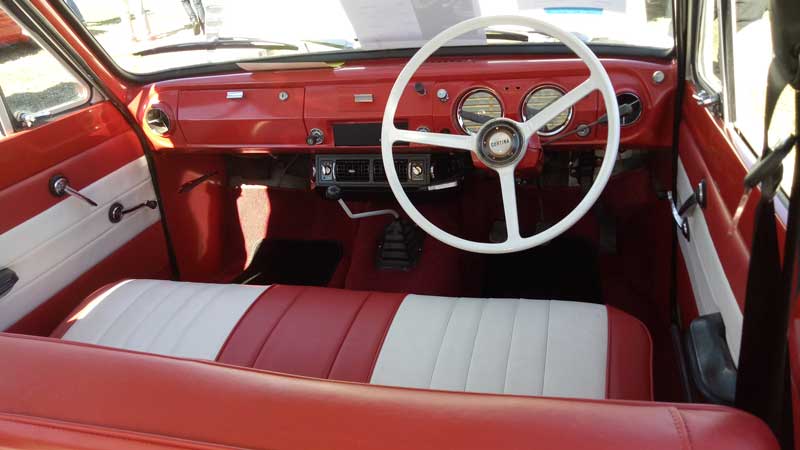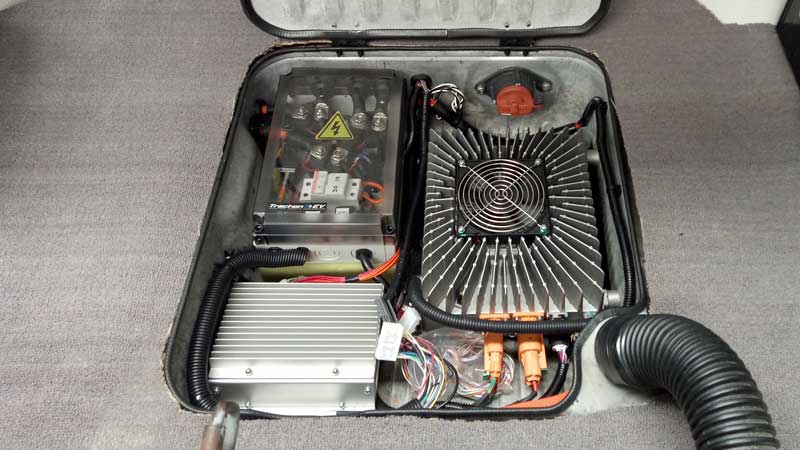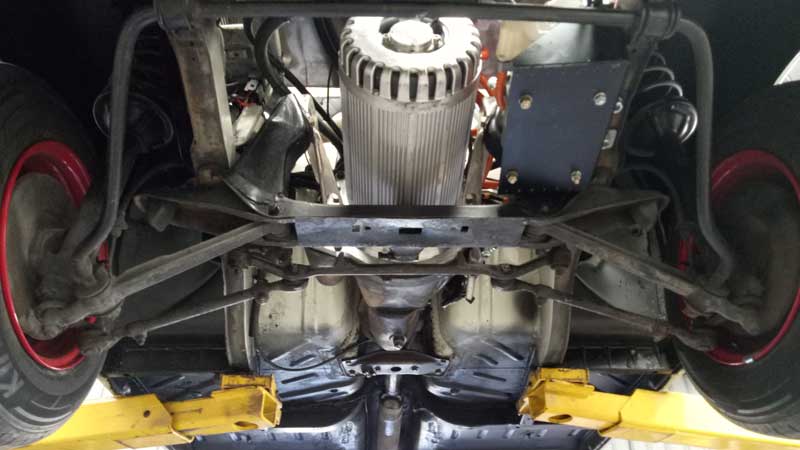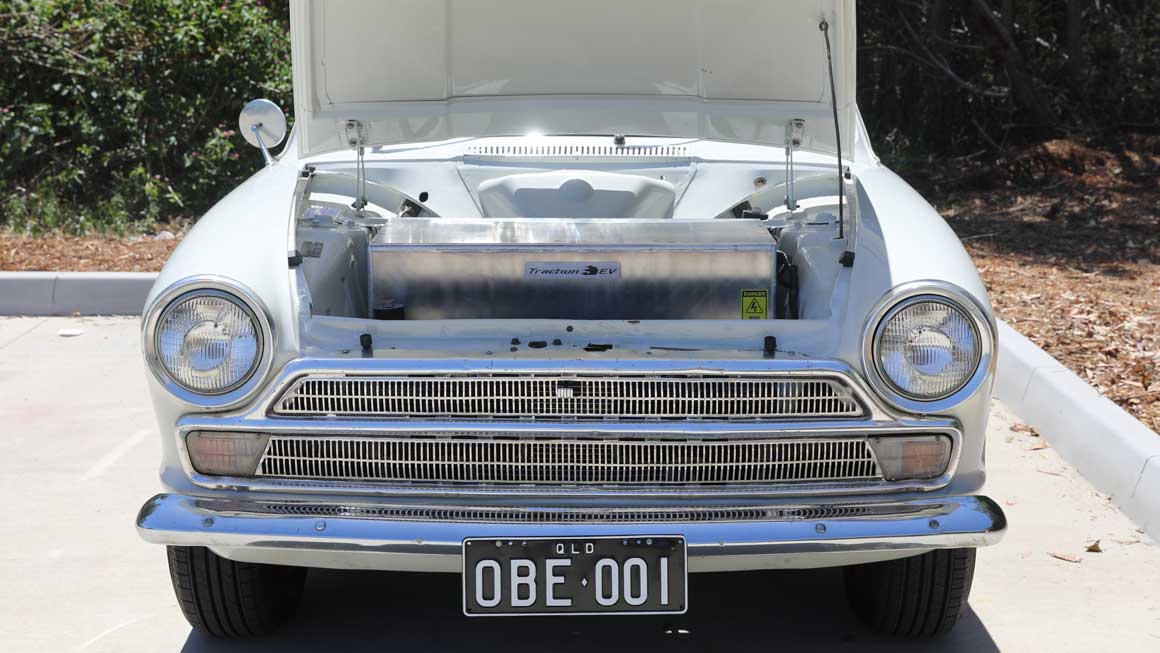Out of the ruins of a wrecked Model X has sprung forth an electric Cortina, resurrected to bring a classic car into the modern age of electric mobility.
For Tim Harrison, an electric vehicle charging infrastructure planner for Evie Networks, the 100% all electric Mk1 Cortina is the realisation of a long held dream of having an electric classic car. And it’s not just any conversion.
For a start, it packs more than triple the power and torque of the Mk1 Cortina’s original 1500 engine.
Inspired by legendary musician Neil Young whose converted hybrid-electric 1959 Lincoln broke the mold for classic cars in 2008, Harrison has also packed loads of modern conveniences into the small but sprightly package, including air conditioning and regenerative braking, and he ability to use DC fast chargers.
But the game changer, says Harrison, was being able to take advantage of battery tech from a written off Model X.
“As much as I wanted one, I couldn’t afford a Tesla, so I decided I had to undertake a conversion project,” Harrison tells The Driven.
“I worked out the perfect candidate to convert – a Mk1 Cortina – which is still a relatively affordable classic to find; is small and light but still has plenty of room to stuff batteries; and has a certain understated style while still being able to fit a family.
“Finding a wrecked Tesla Model X and stripping it down for batteries really changed the game and allows all of Tesla’s battery R&D to be utilised to really give these old cars the very latest technology.
“The 28kWh Tesla battery pack is large enough to get a decent range of 180km but not too heavy or bulky enough to hinder the suspension, weight distribution, or render the boot useless, as is the case with some conversions.”
The final weight was just over 1000kg, compared to 900kg stock, and front-rear distribution is exactly 50-50.
A driving range of 180km in an classic car conversion is commendable, but more often than not converted EVs are limited by a slow AC charging rate that can take hours to get it back on the road.
Coming from a DC fast charging infrastructure background, Harrison was determined to ensure his conversion did not suffer the same fate – and that it was comfortable to drive in Brisbane’s warm, subtropical climate.
“The conversion plans morphed over time from humble ambitions to wanting some features that hadn’t been done in classic electromods before, including air conditioning, and DC fast charging capability,” says Harrison.
“As a planner of public EV charging infrastructure, I knew I wanted access to the growing network of public DC chargers.
“Getting this to work was by far the most difficult aspect of the conversion but one of the most satisfying to finally achieve, as it allows me to use many of the charging stations I have planned in my day job and reduces the range anxiety.”
The 120 volt system used by Harrison in the Cortina allows for a maximum DC charge rate of 20kW – which means approximately an hour is needed at a fast charger to top up driving range. The 180km range is enough to allow Harrison to use the Queensland Electric Superhighway (QESH) to travel up the coast.
To ensure having both AC and DC plugs did not compromise the Cortina’s classic body (the AC plug uses the fuel cap location), Harrison took the unusual step of locating the DC CHAdeMO plug in the one place that every internal combustion engine conversion no longer needs – the exhaust pipe.

The result: a stylish, eco-friendly and on the outside at least, completely unadulterated, classic sedan that Harrison can, once final tweaks are applied, use for family trips out of town.
The experience garnered during the conversion process has sparked (had to do it) a plan to help others bring classic cars into the electric age.
“During the process, I started up Charged Garage as a platform to encourage more people to consider electrifying their classic cars, and mainly just to help get more old cars out of sheds and paddocks and back out on the road being enjoye,” says Harrison.
“I’d like to apply modern car-share principles to the classic car ownership model to defray those upfront conversion costs. Instead of a car being constantly tinkered on in the shed and then driven once a month by one owner, why not let several owners or casual users share the car?
“Once cars are converted to electric they can be utilised more, with less maintenance and ongoing costs, and enjoyed by more people.
Buying, storing and maintaining an old car can be a bit daunting but with this concept it’s pretty straightforward just to do the fun part of driving, and it’s sustainable to keep an old car going for another generation.”

Bridie Schmidt is associate editor for The Driven, sister site of Renew Economy. She has been writing about electric vehicles since 2018, and has a keen interest in the role that zero-emissions transport has to play in sustainability. She has participated in podcasts such as Download This Show with Marc Fennell and Shirtloads of Science with Karl Kruszelnicki and is co-organiser of the Northern Rivers Electric Vehicle Forum. Bridie also owns a Tesla Model Y and has it available for hire on evee.com.au.







